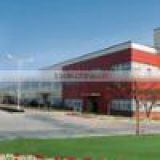china magnet suppliers ceramic ferrite magnet Quality Choice
USD $0.01 - $1,000 /Piece
Min.Order:100 Pieces
Quick Details View All >
Ningbo Risheng Magnets Co., Ltd.
Product Details
Ceramic ferrite magnet is made of SrO or BaO and Fe2O3 by ceramic processing technology. Ceramic ferrite magnet is very hard and brittle, and require specialized machining techniques. Moreover, they should be machined in an unmagnetized state. Due to their low cost, ceramic ferrite magnet enjoys a very wide range of applications, from motors and loudspeakers to toys and crafts, and are the most widely used permanent magnets today.
Manufacturing Process
Pressing and sintering involves pressing very fine ferrite powder in a die firstly, and then sintering this pressed magnet. All fully dense ceramic ferrite magnet is produced this way. Ceramic ferrite magnet can be wet pressed or dry pressed. Wet pressing yields better magnetic properties, but poorer physical tolerances. Generally, the powder is dry for grade 1 or 5 materials, and wet for grade 8 and higher materials.
Sintering involves subjecting the material to high temperatures to fuse the pressed powder together, thus creating a solid material. Ceramic ferrite magnet produced through this process usually need some finish machining, otherwise surface finishes and tolerances are not acceptable. Some manufacturers extrude instead of press wet powder slurry and then sinter the material. This is sometimes done for arc segment shapes, where the arc cross-section is extruded in lengths, sintered, and then cut into length.
Machining
Ceramic ferrite magnet is brittle, and prone to chipping and cracking. Special machining techniques must be used to machine this material. We are fully equipped to machine these materials to your blueprint specifications.
Surface treatments
The corrosion resistance of Ferrite magnet is considered excellent , and no surface treatments are required. However, ceramic ferrite magnet may have a thin film of fine magnet powder on the surface and for clean, non-contaminated applications, some form of coating may be required.
Magnetizing
Ceramic ferrite magnet requires magnetizing fields of about 10 kOe. They can be magnetized with multiple poles on one or both pole surfaces.
Anisotropic grades are oriented in the manufacturing direction, and must be magnetized in the direction of orientation. Isotropic grades are not oriented and can be magnetized in any direction, although some degree of greater magnetic strength will be found in the magnetizing dimension, usually through the shortest dimension.


Magnetic properties of Ferrite magnet
| Grade | Residual Induction | Coercive Force | Maximum Energy Product | Rev. Temp.Coeff. |
| Br | Hcb | (BH)max | Br | |
| mT | kA/m | kJ/m3 | Hcj | |
| [Gs] | [kOe] | [MGOe] | %℃ | |
| LNG10 | 600 | 40 | 10.00 | -0.02 |
| [6000] | [500] | [1.20] | 0.03 | |
| LNG12 | 700 | 44 | 12.00 | -0.02 |
| [7000] | [550] | [1.50] | 0.03 | |
| LNG13 | 680 | 48 | 13.00 | -0.02 |
| [6800] | [600] | [1.63] | 0.03 | |
| LNG18 | 900 | 48 | 18.00 | -0.02 |
| [9000] | [600] | [2.25] | 0.03 | |
| LNG37 | 1200 | 48 | 37.00 | -0.02 |
| [12000] | [600] | [4.63] | 0.03 | |
| LNG40 | 1250 | 48 | 40.00 | -0.02 |
| [12500] | [600] | [5.00] | 0.03 | |
| LNG44 | 1250 | 52 | 44.00 | -0.02 |
| [12500] | [650] | [5.50] | 0.03 | |
| LNG52 | 1300 | 56 | 52.00 | -0.02 |
| [13000] | [700] | [6.50] | 0.03 | |
| LNG56 | 1300 | 58 | 56.00 | -0.02 |
| [13000] | [720] | [7.00] | 0.03 | |
| LNGT60 | 1330 | 60 | 60.00 | -0.02 |
| [13300] | [750] | [7.50] | 0.03 | |
| LNGT72 | 1050 | 112 | 72.00 | -0.02 |
| [10500] | [1400] | [9.00] | 0.03 | |
| LNGT88 | 1100 | 115 | 88.00 | -0.02 |
| [11000] | [1450] | [11.00] | 0.03 | |
| LNGT36J | 700 | 140 | 36.00 | -0.02 |
| [7000] | [1750] | [4.5] | 0.03 | |
| LNGT52J | 900 | 140 | 52.00 | -0.02 |
| [9000] | [1750] | [6.50] | 0.03 |
Physical properties of Ferrite magnets
| Parameters | Units | Indicators |
| Recoil Permeability | Gs/Oe | 1.05-1.3 |
| Curie Temperature | ℃ | ≥450 |
| Temp.Coeff.of Br | ℃/% | -0.2 |
| Temp.Coeff.of Hcj | ℃/% | -0.2-0.5 |
| Density | g/cm3 | 4.6-5.0 |
| Specific Resistance | Ω.cm | ≥106 |
| Coefficient of Thermal Expansion | 10-6/k | 7-15X10-6 |
| Hardness | Rockwell C | 46 - 50 |
Contact Supplier

You May Like

New Products
Popular Searches
Recommended Products
Find Similar Products By Category